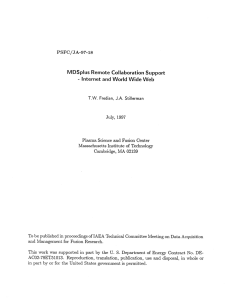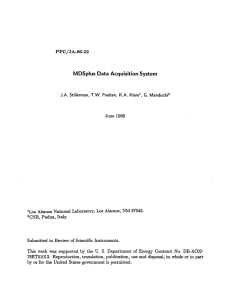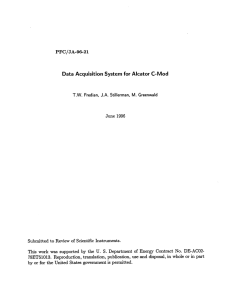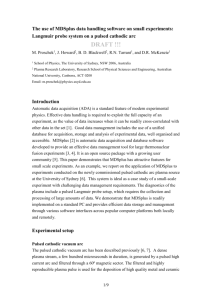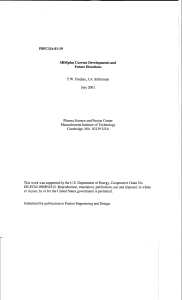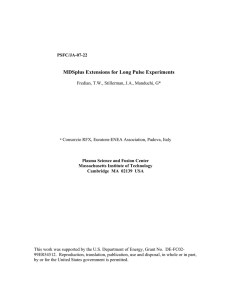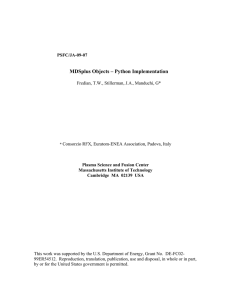joshprague2
advertisement
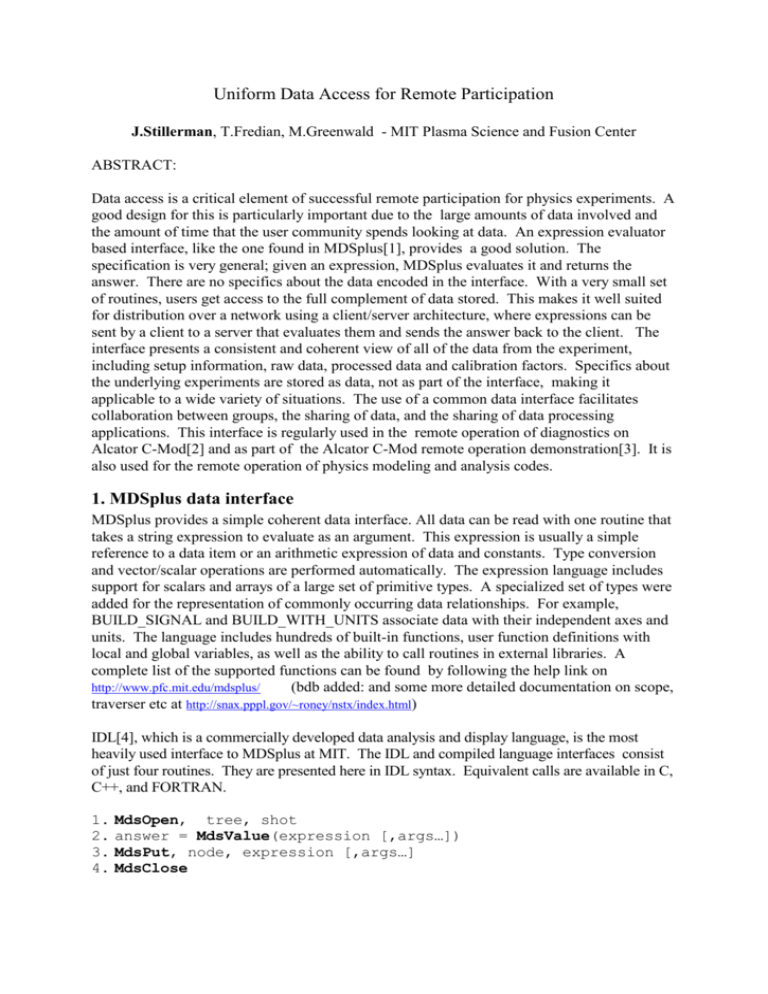
Uniform Data Access for Remote Participation
J.Stillerman, T.Fredian, M.Greenwald - MIT Plasma Science and Fusion Center
ABSTRACT:
Data access is a critical element of successful remote participation for physics experiments. A
good design for this is particularly important due to the large amounts of data involved and
the amount of time that the user community spends looking at data. An expression evaluator
based interface, like the one found in MDSplus[1], provides a good solution. The
specification is very general; given an expression, MDSplus evaluates it and returns the
answer. There are no specifics about the data encoded in the interface. With a very small set
of routines, users get access to the full complement of data stored. This makes it well suited
for distribution over a network using a client/server architecture, where expressions can be
sent by a client to a server that evaluates them and sends the answer back to the client. The
interface presents a consistent and coherent view of all of the data from the experiment,
including setup information, raw data, processed data and calibration factors. Specifics about
the underlying experiments are stored as data, not as part of the interface, making it
applicable to a wide variety of situations. The use of a common data interface facilitates
collaboration between groups, the sharing of data, and the sharing of data processing
applications. This interface is regularly used in the remote operation of diagnostics on
Alcator C-Mod[2] and as part of the Alcator C-Mod remote operation demonstration[3]. It is
also used for the remote operation of physics modeling and analysis codes.
1. MDSplus data interface
MDSplus provides a simple coherent data interface. All data can be read with one routine that
takes a string expression to evaluate as an argument. This expression is usually a simple
reference to a data item or an arithmetic expression of data and constants. Type conversion
and vector/scalar operations are performed automatically. The expression language includes
support for scalars and arrays of a large set of primitive types. A specialized set of types were
added for the representation of commonly occurring data relationships. For example,
BUILD_SIGNAL and BUILD_WITH_UNITS associate data with their independent axes and
units. The language includes hundreds of built-in functions, user function definitions with
local and global variables, as well as the ability to call routines in external libraries. A
complete list of the supported functions can be found by following the help link on
http://www.pfc.mit.edu/mdsplus/
(bdb added: and some more detailed documentation on scope,
traverser etc at http://snax.pppl.gov/~roney/nstx/index.html)
IDL[4], which is a commercially developed data analysis and display language, is the most
heavily used interface to MDSplus at MIT. The IDL and compiled language interfaces consist
of just four routines. They are presented here in IDL syntax. Equivalent calls are available in C,
C++, and FORTRAN.
1.
2.
3.
4.
MdsOpen, tree, shot
answer = MdsValue(expression [,args…])
MdsPut, node, expression [,args…]
MdsClose
These four routines provide complete read and write access to the MDSplus data system. The
optional arguments to MdsValue and MdsPut are values that are substituted into the expression
before it is evaluated or written.
The compactness of this interface makes it very easy to set up a client/server based interface for
remote access. We add:
1. MdsConnect, host [,port]
2. MdsDisconnect
and the expressions, instead of being evaluated locally, are sent over the network and are
evaluated by a server process on a remote node.
Using just these six routines we can write a data analysis program that connects to a computer
at MIT, reads in processed signals and their shared timebase, computes a result and stores the
answer in a node called ‘\analysis::top.results:poh’. This syntax describes the hierarchical
name of this data item with the ‘.’s and ‘:’s separating parts of the name. The stored result is a
BUILD_SIGNAL which associates the answer in amps with the timebase.
POH.PRO
;procedure to calculate oh power
;
pro poh,shot,poh,t
; connect to the data server at MIT
MdsConnect, ‘daqa.pfc.mit.edu’
; open the analysis tree and get efit data
MdsOpen,'analysis',shot
li = MdsValue('\efit_aeqdsk:ali')
majr = MdsValue('\efit_aeqdsk:rmagx')
ip = MdsValue('\efit_aeqdsk:pasmat')
psibry = MdsValue('\efit_ssibry')
t = MdsValue('dim_of(\efit_aeqdsk:ali)')
; compute the OH Power
vs = -6.283*deriv(t,psibry) ;surface voltage
l = 6.283*majr*li*1.e-9
;plasma inductance
vi = l*deriv(t,ip)
;inductive voltage
vres = vs - vi
;resistive voltage
poh = ip*vres
; write the results back into tree and close file
MdsPut,'\analysis::top.results:poh',
'build_signal(build_with_units($,”Watts”),*, $)’,poh,t
MdsClose
MdsDisconnect
return
end
An important thing to note in the above example is that the interface (MdsConnect, MdsOpen,
etc…) does not contain particulars about the experiment or the data. These are all encoded in
the string arguments which contain the actual names of the signals. This means that the
program could just as easily connect to a computer at another site and process the data
remotely. Figure 1. below shows a screen capture from an application which displays data
from multiple sites around the world.
2. Access to other data formats
The above discussion and example describe the interface to MDSplus. It shows how it can be
easily distributed using a client/server design. In order to be generally useful, access to data
stored by other data systems is also necessary. This is easily accomplished using the
expression evaluator’s external call mechanism.. The syntax used is:
image-name->routine-name([argument, …])
The original intent of this was to call external mathematics, statistics and data processing
routines. It can just as easily call the data access routines of non MDSplus data systems.
Using this capability, General Atomic has constructed MDSplus trees that provide access to
both their existing data system, called PTDATA[5], and new processed results that are stored
in native MDSplus format. Their data access function, written in the expression evaluator
language, makes two calls using the above syntax and returns a signal with time and units.
FUN PUBLIC PTDATA(IN _pointname,OPTIONAL IN _shot,
OPTIONAL OUT _error)
{
_npts = PTSHR->MDSPTNPTS(_shot, _pointname, ref(_error));
if (_error == 0) {
…
_nret = PTSHR->MDSPTREAD(_shot, _pointname, REF(_f), REF(_t),
_npts, DESCR(_date),
DESCR(_time), DESCR(_units),
REF(_error));
if (error == 0) {
return( MAKE_SIGNAL( MAKE_WITH_UNITS( _f, _units), ,
MAKE_WITH_UNITS(_t, "ms")));
}
}
This function could either be called directly in MdsValue:
y = MdsValue(‘_SIG=PTDATA(“name”, shot)’)
x = MdsValue(‘DIM_OF(_SIG)’)
or referenced from within an MDSplus tree. In practice, a native MDSplus tree was
constructed containing these expressions, to simplify the data access. A similar function was
written to provide access to the TFTR waveform[6] data.
The following screen capture is from an application that connects to C-MOD, DIII-D, TFTR,
RFX and TCV, reads and plots the plasma current from a shot from each. Here is part of the
IDL code that generated the picture:
MdsConnect, “daqa.pfc.mit.edu”
MdsOpen, “CMOD”, 980203033
IP = MdsValue(‘\IP*-1E-6’)
TM =MdsValue(‘DIM_OF(\IP)’)
PLOT, TM, IP, title = “CMOD”
;
;
;
;
connect to C-Mod Host
open the shot
scale positive Mamp
read the timebase
MdsConnect, “OMEGA.GAT.GOV”
; connect to DIII-D
IP = MdsValue(‘_IP=PTDATA(“IP”, 96016)*1E-6’)
TM = MdsValue(‘DIM_OF(_IP)*1E-3’)
; etc…
Figure 1. Mulitple Site Data Access
The above examples demonstrate the power and flexibility of an expression based interface
library. It is simple to use, independent of the details of the data being accessed, and works
well in a distributed environment.
3. Current/Future Projects
We are currently porting MDSplus to a variety of unix platforms as well as Windows/NT.
Data access and the TCPIP data server are currently working on most platforms. Given this, it
could be used to access the data from most of the fusion energy experiments around the world.
Interfaces to physics simulation and analysis codes like TRANSP[7] , MIST[8] and EFIT[9]
have been developed and there is ongoing work with the NTCC[10] to generalize this.
The security model in the current TCPIP data server is weak, verifying access only on the
basis of node and username. If this data server is to become more widely used, stronger
mechanisms will need to be employed. The protocol could either be layered on top of existing
secure protocols like DCE, KERBEROS, IPV6, SSL or a locally implemented encryption
scheme for the packets.
At this time only expression strings, and arrays and scalars of primitive types are transmitted
to the data server. The client asks the server for the value of an expression, the server
evaluates and transmits the answer back. We are looking into sending higher level objects;
this would allow us to trade off the relative price and performance of network bandwidth, and
local and remote computing resources. This will be transparent to the users, since they only
deal with this at a higher level of the interface.
4. Conclusion
A standardized interface to experimental and simulation data would greatly enhance the
ability to share data, analysis codes and display tools throughout the fusion community. Such
an interface would need to be quite general to handle all of the different storage formats and
data structures in use. The interface should also work in a client/server environment enabling
the applications to run on computers located anywhere on the Internet.
We have found that the interface to data implemented in the MDSplus data system fulfills
most of these requirements. The expression evaluator built into MDSplus provides a general
data access mechanism for all types of data stored in MDSplus data files as well as powerful
tool for building gateways to non-MDSplus data systems. In addition, the client/server
version of the interface provides access to data from anywhere on the internet.
[1] J.Stillerman, T.Fredian, K.Klare, G.Manduchi, "MDSplus data acquisition system", Review
of Scientific Instruments Vol 68 No 1 January 1997.
[2] B. Welch, et al. "Visible and Ultraviolet Light Measurements from Alcator C-Mod", Bulletin
of the American Physical Society, 38, 1957(1993).
[3] S. Horne, M. Greenwald, et. al., “Remote control of Alcator C-Mod from LLNL”, Fusion
Technology, 32, (1997), 152.
[4] IDL is a registered trademark of Research Systems, Incorporated.
[5] B. McHarg, Jr. "Access to DIII-D Data Located in Multiple Files and Multiple Locations",
Proceedings of the 1993 IEEE 15th Symposium on Fusion Engineering. IEEE, Piscatawy, NJ.
ISBN 0-7803-1412-3 (1994).
[6] L.Randerson, J.Chu, C.Ludescher, et al., “TFTR Data Management System”, Review of
Scientific Instruments 57:(8) 1892-1894 August 1986.
[7] J.Schachter, "Local Transport Analysis for the Alcator C-Mod Tokamak", PFC/RR-97-2,
pp217-265. MIT Plasma Science and Fusion Center, Cambridge, MA, June 1997.
[8] R.Hulse, Nucl. Tech./Fus. Vol. 3, 259 (1983).
[9] L.Lao, H.St.John, R.Stambaugh, A.Kellerman, and W.Pfeiffer, Nucl. Fusion 25, 1611
(1985).
[10] A.Kritz, et al. , “Remote Participation in the United States National Transport Code
Collaboration”, These proceedings.
